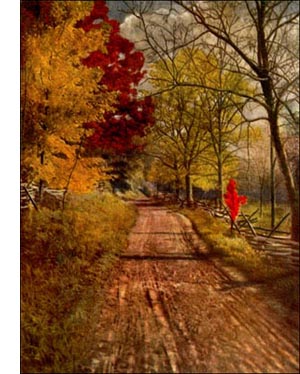Douglas Spruce or Red Fir Tree
 Douglas Spruce, Red Fir (Pseudotsuga mucronata, Sudw.) -Pyramidal or flat-topped tree, 150 to 250 feet high, with long, bare trunk in forest; in the open, a broad-based pyramid. Branches slender, crowded, long, drooping. Spray finely divided. Bark thick, deeply furrowed, with rounded irregular ridges coated with red scales. Wood pale red or yellow, durable in water and soil; variable in quality, usually tough and hard. Buds scaly, acute. Leaves straight, linear, blunt at apex, 1 to 1 1/2 inches long, yellowish or bluish green, shed in eighth year. Flowers conelike, staminate orange-red, pistillate red. Fruit a long-stemmed cone, 2 to 4 inches long, drooping, scales thin, with entire margins; bracts ending in recurved, whip-like points. Preferred habitat, moist soil of coast plain. Distribution, Rocky Mountains from British America into Mexico; west to Pacific coast, except in the Great Basin (between Wasatch and Sierra Nevada Mountains). Uses: Valuable lumber tree for shipbuilding, piles, posts and railroad ties. Bark used to some extent for tanning.
Douglas Spruce, Red Fir (Pseudotsuga mucronata, Sudw.) -Pyramidal or flat-topped tree, 150 to 250 feet high, with long, bare trunk in forest; in the open, a broad-based pyramid. Branches slender, crowded, long, drooping. Spray finely divided. Bark thick, deeply furrowed, with rounded irregular ridges coated with red scales. Wood pale red or yellow, durable in water and soil; variable in quality, usually tough and hard. Buds scaly, acute. Leaves straight, linear, blunt at apex, 1 to 1 1/2 inches long, yellowish or bluish green, shed in eighth year. Flowers conelike, staminate orange-red, pistillate red. Fruit a long-stemmed cone, 2 to 4 inches long, drooping, scales thin, with entire margins; bracts ending in recurved, whip-like points. Preferred habitat, moist soil of coast plain. Distribution, Rocky Mountains from British America into Mexico; west to Pacific coast, except in the Great Basin (between Wasatch and Sierra Nevada Mountains). Uses: Valuable lumber tree for shipbuilding, piles, posts and railroad ties. Bark used to some extent for tanning.He who would see for himself the most magnificent forests this continent holds to-day must go to the redwoods in California. When these groves have awed him with the tremendous bulk of timber in board feet they can yield in a single acre, let him move up the coast to where the moist Japan current breathes upon the evergreen forests of the Cascade's western slope. There are giant cedars and firs and hemlocks; and dominating all of them is the Douglas spruce.
" It is not only a large tree, the tallest in America next to the redwood, but a very beautiful one with bright green, drooping foliage, handsome pendant cones, and a shaft, exquisitely straight and round and regular."
The trees make a very even growth and stand together as closely as the stalks in a well-tilled field of grain. Excluding other kinds, these trees stand with their heads together, making the forest dark as night below. Far up the Alaskan coast the Douglas spruce extends, and eastward across mountain ranges, where it mingles with yellow pines in sunny, open forests, where the trees have opportunity to show the grace of their pendant limbs and the beauty of their red cone flowers and the ruddy cones adorned with pale green bracts. A small cone it is for so large a tree, yet one to remember for its beauty.
The Douglas spruce is known as "Oregon pine" in the lumber markets of the coast. The Puget Sound region furnishes spars of it to every great shipyard in the world. They are used as piles in wharves in Western harbours. Shipbuilders, bridgebuilders-everybody who needs heavy timbers of great durability, toughness and hardness--desire this kind if it can be had. T he best grades of it are stronger than the wood of any other large conifer in America. Its faults for general lumber purposes are its hardness and its tendency to warp in boards.
The Douglas spruce as seen in nurseries is the quickestgrowing evergreen of all. Immense quantities of seed are sent to Europe, where the tree is grown both for ornament and for timber. The seed produces a large percentage of vigorous seedlings, and they transplant well. In the eastern and northern parts of the United States the trees do well from seed gathered in the Rocky Mountains. Failures in seedlings imported from European nurseries are traceable to the fact that seeds came from the Pacific coast plain, and the seedlings therefore are not hardy in the more rigorous climate of the East and North. In the seeds furnished by high mountain trees this difficulty is overcome. Even in the droughty regions of Kansas and Nebraska these trees planted in sheltered situations and in clumps grow into trees of exceeding beauty. Exposed in windbreaks the foliage is damaged, the trees lose their " leaders," and acquire bad shapes thereafter.